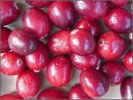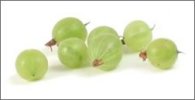2016年8月30日 星期二
2016年8月22日 星期一
The 15 Healthiest Berries You Could Possibly Eat
The 15 Healthiest Berries You Could Possibly Eat ... Including 7 Most Haven't Heard Of
by www.SixWise.com
by www.SixWise.com
Fresh berries hanging from a branch are some of summer's most anticipated gifts. Now is the time of year when these naturally sweet, tasty treats are available in plenty, but you can enjoy them in frozen varieties year-round. So go ahead and indulge in all that berries have to offer--a sweet, juicy taste reminiscent of long summer days, an easy addition to snacks and meals, and, best of all, incredible health benefits for you and your family.
Here are fifteen of the healthiest ... and tastiest.
| 1. Blueberry |
 The blueberry is quite possibly the healthiest fruit there is--it ranked number one in antioxidant capacity by researchers at the USDA Human Nutrition Center when compared to 40 other fresh fruits and vegetables. The blueberry is quite possibly the healthiest fruit there is--it ranked number one in antioxidant capacity by researchers at the USDA Human Nutrition Center when compared to 40 other fresh fruits and vegetables."When it comes to brain protection, there's nothing quite like blueberries," says Tufts neuroscientist James Joseph. "I call the blueberry the brain berry," he says, attributing the effect to their antioxidant and anti-inflammatory properties. And the American Institute for Cancer Research has this to say: "We now know that blueberries are one of the best sources of antioxidants, substances that can slow the aging process and reduce cell damage that can lead to cancer." Aside from protecting the brain and fighting cancer, blueberries have been associated with lower cholesterol, protection against heart disease, macular degeneration, glaucoma, varicose veins, hemorrhoids and peptic ulcers, and healthier elimination. Rich in vitamins C and E, manganese and dietary fiber, about 30 different species of blueberries grow throughout the United States and Canada. |
| 2. Cherry |
 As if their sweet taste wasn't enough of a reason to eat them, cherries are rich in queritrin (a flavonoid that's a potent anti-cancer agent), anthocyanins and bioflavonoids (compounds that fight the pain from arthritis, gout and migraines), ellagic acid (another potent anti-cancer agent) and melatonin (which may help you sleep). They also contain the soluble fiber pectin, vitamin C, beta-carotene and potassium. As if their sweet taste wasn't enough of a reason to eat them, cherries are rich in queritrin (a flavonoid that's a potent anti-cancer agent), anthocyanins and bioflavonoids (compounds that fight the pain from arthritis, gout and migraines), ellagic acid (another potent anti-cancer agent) and melatonin (which may help you sleep). They also contain the soluble fiber pectin, vitamin C, beta-carotene and potassium.If it seems like cherries are only around for a short time, you're right--their season is only three months long. Cherries come in two basic varieties, sweet and sour. The Bing cherry is the most popular of the sweet cherries and is best for snacking, while the smaller and brighter sour cherries are most often used for pies, sauces or other baked goods. For a treat, try the incredibly sweet and selectively grown Rainier cherries. |
| 3. Strawberry |
 Like other berries, strawberries contain phytonutrients called phenols that make it a heart-protective, anti-cancer and anti-inflammatory fruit. Strawberries also help protect the brain from oxidative stress and age-related decline and fight macular degeneration of the eyes. They're an excellent source of vitamins C and K, manganese, fiber and iodine, and they contain potassium, folate, riboflavin, vitamin B5, omega-3 fatty acids, vitamin B6, magnesium and copper. Like other berries, strawberries contain phytonutrients called phenols that make it a heart-protective, anti-cancer and anti-inflammatory fruit. Strawberries also help protect the brain from oxidative stress and age-related decline and fight macular degeneration of the eyes. They're an excellent source of vitamins C and K, manganese, fiber and iodine, and they contain potassium, folate, riboflavin, vitamin B5, omega-3 fatty acids, vitamin B6, magnesium and copper.There are over 600 varieties of berries out there, and they can be used in everything from salads to breakfast shakes to desserts. Because strawberries don't ripen any further once they're picked, be sure to choose shiny berries with a deep red color and use them within a few days. |
| 4. Bilberry |
 Similar to the blueberry, bilberries are often referred to as European blueberries. They're rich in antioxidants and are widely known as a potent protector of the eyes and have been linked to improvements in night vision, cataracts, macular degeneration and vision overall. Similar to the blueberry, bilberries are often referred to as European blueberries. They're rich in antioxidants and are widely known as a potent protector of the eyes and have been linked to improvements in night vision, cataracts, macular degeneration and vision overall.Interestingly, the eye-protective benefits of bilberries were first noticed during World War II when British Royal Air Force (RAF) pilots discovered that they had better night vision on bombing raids when they ate bilberry preserves beforehand. The bilberry also contains compounds that enhance blood flow to circulatory vessels, which means it may be beneficial for circulatory problems including varicose veins, hemorrhoids and more. Bilberries taste just like blueberries, but they're about three times smaller in size. |
| 5. Blackberry |
 Blackberries contain antioxidants, vitamins C and E, and ellagic acid, all of which may protect against cancer and fight chronic disease. They're also rich in the soluble fiber pectin, which may help lower cholesterol, and potassium. Blackberries contain antioxidants, vitamins C and E, and ellagic acid, all of which may protect against cancer and fight chronic disease. They're also rich in the soluble fiber pectin, which may help lower cholesterol, and potassium.Wild blackberries are actually related to the rose, and, like a rose, they grow on a thorny bush. Because they're highly perishable (like all berries), blackberries should, ideally, be used the same day they're bought and washed just prior to eating. You can also freeze them by placing them in a single layer on a cookie sheet and then, once frozen, transferring them to an airtight container. They'll keep for about six months. |
| 6. Elderberry |
 In 400 B.C., Hippocrates referred to the elder tree as his "medicine chest," and it's been used since ancient times to treat colds, flus, arthritis, constipation and more. Today, the elderberry is still in popular demand when it comes to health, especially in Austria, Germany and England. In 400 B.C., Hippocrates referred to the elder tree as his "medicine chest," and it's been used since ancient times to treat colds, flus, arthritis, constipation and more. Today, the elderberry is still in popular demand when it comes to health, especially in Austria, Germany and England.Elderberries contain plenty of antioxidants, anti-viral compounds, anthocyanins that help enhance immune function, and compounds that help lower LDL (bad) cholesterol. The berries are small and round and range in color from dark purple to bluish-black.Elderberries should not be eaten raw, as they're mildly poisonous and can cause nausea or vomiting if eaten unripe (and they're quite sour). The mild toxicity is destroyed by cooking, though, so the berries are typically used to make jams, jellies and homemade wine. They can also be used in place of blueberries in things like muffins, cakes and pies. |
| 7. Goji Berries |
 It's said that a handful of goji berries in the morning will make you happy for the rest of the day. Traditionally, they're regarded as a potent food for longevity, strength and sexual virility and are grown in Tibet in protected valleys that contain million-year-old soil that's reportedly untouched by pollutants or pesticides. It's said that a handful of goji berries in the morning will make you happy for the rest of the day. Traditionally, they're regarded as a potent food for longevity, strength and sexual virility and are grown in Tibet in protected valleys that contain million-year-old soil that's reportedly untouched by pollutants or pesticides.As tradition goes, the berries are never touched by human hands (this would cause them to oxidize and turn black), but instead are shaken onto mats and then dried or made into a liquid juice. There's even a legend that says Li Qing Yuen, who "lived to the age of 252 years" (1678-1930), ate Goji berries every day. Modern day studies have also found some benefits to goji berries; they've been said to have potential in fighting cancer and protecting the liver. Goji berries contain 18 amino acids, 21 trace minerals, linoleic acid, more beta carotene than carrots, vitamins B1, B2, B6, and E, selenium and germanium. Goji berries are deep red in color and about the same size as a raisin. They taste like a cranberry combined with a cherry, and are typically eaten dried or in juice form. |
| 8. Lingonberries |
 These small, red, oval fruits (they're about the size of a large pea) are a popular treat in Finland and other Nordic countries where their tart flavor is enjoyed in sauces and jellies. These small, red, oval fruits (they're about the size of a large pea) are a popular treat in Finland and other Nordic countries where their tart flavor is enjoyed in sauces and jellies.Lingonberries are rich in the flavonoid quercetin, which is a plant antioxidant that may help to prevent cancer and heart disease. Fresh lingonberries are not easy to find in the United States, but if you do find them, you can use them as you would a cranberry. They're often eaten crushed and mixed with sugar or cooked into sauces, jams, jellies, juice and wine. If you haven't heard of the lingonberry, maybe you've heard of one of its numerous other names: cowberry, red whortle berry, foxberry, northern mountain cranberry, dry ground cranberry, rock cranberry, partridge berry or whimberry. Or maybe not. |
| 9. Cranberries |
 One of the most popular uses of cranberries, to treat urinary tract infections, has been used for centuries by indigenous cultures. Today researchers have found that cranberries contain proanthocyanidins (PACs), which inhibit bacteria, including E. coli, from adhering to the urinary tract, thereby protecting it from infection. One of the most popular uses of cranberries, to treat urinary tract infections, has been used for centuries by indigenous cultures. Today researchers have found that cranberries contain proanthocyanidins (PACs), which inhibit bacteria, including E. coli, from adhering to the urinary tract, thereby protecting it from infection.They're also rich in antioxidants that may play a role in preventing heart disease and cancer, and may play a role in preventing peptic ulcers by inhibiting H. pylori from adhering to the stomach. Because cranberries are so tart, they're not usually eaten raw but instead are baked into pies, muffins and cakes, used as a juice or cooked into the American holiday favorite, cranberry sauce. |
| 10. Raspberry |
 Raspberries are rich in phytonutrients for antioxidant, antimicrobial and anticarcinogenic protection. Chief among these is ellagic acid, the potent cancer fighter. Raspberries have also been found to help prevent macular degeneration, and they contain manganese, vitamin C, riboflavin, folate, niacin, magnesium, potassium, dietary fiber and copper. Raspberries are rich in phytonutrients for antioxidant, antimicrobial and anticarcinogenic protection. Chief among these is ellagic acid, the potent cancer fighter. Raspberries have also been found to help prevent macular degeneration, and they contain manganese, vitamin C, riboflavin, folate, niacin, magnesium, potassium, dietary fiber and copper.Raspberries have a long history--they can be traced all the way back to prehistoric times--but began to be grown widely in the 19th century, when many new varieties, including the loganberry and boysenberry, were developed. Raspberries have a sweet, tangy taste that makes them a popular treat for snacks, desserts, salads, cereals, sauces, baking, jams, jellies and more. |
| 11. Dewberry |
 Dewberries are closely related to raspberries and blackberries, with the same sweet taste, but are slightly smaller and typically purple in color. It is likely that they present similar health benefits to raspberries and blackberries. Dewberries are closely related to raspberries and blackberries, with the same sweet taste, but are slightly smaller and typically purple in color. It is likely that they present similar health benefits to raspberries and blackberries. |
| 12. Mulberry |
 Traditionally, mulberry fruit has been used medicinally to treat the kidneys, fatigue, anemia and weakness. Although not widely studied, it's thought that mulberries contain high levels of antioxidants and similar health benefits as other dark-colored berries like blueberries, blackberries and raspberries. Traditionally, mulberry fruit has been used medicinally to treat the kidneys, fatigue, anemia and weakness. Although not widely studied, it's thought that mulberries contain high levels of antioxidants and similar health benefits as other dark-colored berries like blueberries, blackberries and raspberries.The mulberry has a sweet, somewhat bland flavor, and is commonly used in jelly, wine and desserts. In its dry form, the mulberry can be used as a raisin substitute. |
| 13. Gooseberry |
 These fruits grow wild throughout the United States, but they're typically cultivated in more tropical locations like Hawaii and South Africa. They can range in color from white to green to pink or purple, and they're typically about 1/2 to 1 inch wide (though some varieties can grow as big as plums!). These fruits grow wild throughout the United States, but they're typically cultivated in more tropical locations like Hawaii and South Africa. They can range in color from white to green to pink or purple, and they're typically about 1/2 to 1 inch wide (though some varieties can grow as big as plums!).Gooseberries have a sweet/sour taste somewhere between a strawberry and a pineapple. Though not too common in the United States these days, they taste great in pies, jams, jellies and cooked sauces, or eaten fresh, if you can find them. If you're looking for a sweeter berry, choose a gooseberry with a pinkish hue. The green berries are unripe and work best for sauces and pies. Gooseberries have similar nutritional qualities as strawberries, cranberries and other berries. |
| 14. Huckleberry |
 Huckleberries look just like blueberries (and are often confused with them) and taste like them too (but a bit more tart), but contain seeds that give them a unique crunchy texture. The seeds are edible, so they can be used interchangeably with blueberries, but, since they're not grown commercially, you'll have to find them in the wild. Huckleberries look just like blueberries (and are often confused with them) and taste like them too (but a bit more tart), but contain seeds that give them a unique crunchy texture. The seeds are edible, so they can be used interchangeably with blueberries, but, since they're not grown commercially, you'll have to find them in the wild.Huckleberries have not been studied extensively, but may have similar health benefits as blueberries. |
| 15. Chokeberry |
 Purple berries like chokeberries may possess as much as 50 percent more antioxidants than more common berries, according to the U.S. Department of Agriculture. Purple berries like chokeberries may possess as much as 50 percent more antioxidants than more common berries, according to the U.S. Department of Agriculture.However, the raw berries are extremely tart (hence the name "chokeberry"), so they're best when cooked and made into juice, jam or wine. |
2016年8月11日 星期四
Ubuntu版本代號命名
https://zh.wikipedia.org/wiki/Ubuntu
Ubuntu 4.10 Warty Warthog 多疣的疣豬
Ubuntu 5.04 Hoary Hedgehog 白髮的刺蝟
Ubuntu 5.10 Breezy Badger 活潑的獾
Ubuntu 6.06 Dapper Drake 整潔的公鴨
Ubuntu 6.10 Edgy Eft 尖利的小蜥蜴
Ubuntu 7.04 Feisty Fawn 煩躁不安的鹿
Ubuntu 7.10 Gutsy Gibbon 膽大的長臂猿
Ubuntu 8.04 Hardy Heron 堅強的鷺
Ubuntu 8.10 Intrepid Ibex 無畏的羱羊
Ubuntu 9.04 Jaunty Jackalope活潑的鹿角兔
Ubuntu 9.10 Karmic Koala 幸運的無尾熊
Ubuntu 10.04 Lucid Lynx 清醒的山貓
Ubuntu 10.10 Maverick Meerkat標新立異的的狐獴
Ubuntu 11.04 Natty Narwhal 敏捷的獨角鯨
Ubuntu 11.10 Oneiric Ocelot 有夢的虎貓
Ubuntu 12.04 Precise Pangolin精準的穿山甲
Ubuntu 12.10 Quantal Quetzal 量子的格查爾鳥
Ubuntu 13.04 Raring Ringtail 卯足了勁的環尾貓熊
Ubuntu 13.10 Saucy Salamander活潑的蠑螈
Ubuntu 14.04 Trusty Tahr 可靠的塔爾羊
Ubuntu 14.10 Utopic Unicorn 烏托邦的獨角獸
Ubuntu 15.04 Vivid Vervet 活潑的長尾黑顎猴
Ubuntu 15.10 Wily Werewolf 老謀深算的狼人
Ubuntu 16.04 Xenial Xerus 好客的非洲地松鼠
Ubuntu 16.10 Yakkety Yak 氂牛
Ubuntu 4.10 Warty Warthog 多疣的疣豬
Ubuntu 5.04 Hoary Hedgehog 白髮的刺蝟
Ubuntu 5.10 Breezy Badger 活潑的獾
Ubuntu 6.06 Dapper Drake 整潔的公鴨
Ubuntu 6.10 Edgy Eft 尖利的小蜥蜴
Ubuntu 7.04 Feisty Fawn 煩躁不安的鹿
Ubuntu 7.10 Gutsy Gibbon 膽大的長臂猿
Ubuntu 8.04 Hardy Heron 堅強的鷺
Ubuntu 8.10 Intrepid Ibex 無畏的羱羊
Ubuntu 9.04 Jaunty Jackalope活潑的鹿角兔
Ubuntu 9.10 Karmic Koala 幸運的無尾熊
Ubuntu 10.04 Lucid Lynx 清醒的山貓
Ubuntu 10.10 Maverick Meerkat標新立異的的狐獴
Ubuntu 11.04 Natty Narwhal 敏捷的獨角鯨
Ubuntu 11.10 Oneiric Ocelot 有夢的虎貓
Ubuntu 12.04 Precise Pangolin精準的穿山甲
Ubuntu 12.10 Quantal Quetzal 量子的格查爾鳥
Ubuntu 13.04 Raring Ringtail 卯足了勁的環尾貓熊
Ubuntu 13.10 Saucy Salamander活潑的蠑螈
Ubuntu 14.04 Trusty Tahr 可靠的塔爾羊
Ubuntu 14.10 Utopic Unicorn 烏托邦的獨角獸
Ubuntu 15.04 Vivid Vervet 活潑的長尾黑顎猴
Ubuntu 15.10 Wily Werewolf 老謀深算的狼人
Ubuntu 16.04 Xenial Xerus 好客的非洲地松鼠
Ubuntu 16.10 Yakkety Yak 氂牛
2016年8月9日 星期二
2016年8月6日 星期六
2016年8月5日 星期五
2016年8月4日 星期四
人孔蓋英文Manhole cover
http://teacherluke.co.uk/2011/10/12/billy-connolly-interview-more-scottish-accent/
https://en.wikipedia.org/wiki/Manhole_cover
撞到電線杆 & 掉入人孔蓋
我必須說Luke真得太幽默了
聽Podcast要小心自身安全喔
https://en.wikipedia.org/wiki/Manhole_cover
撞到電線杆 & 掉入人孔蓋
我必須說Luke真得太幽默了
聽Podcast要小心自身安全喔
訂閱:
意見 (Atom)